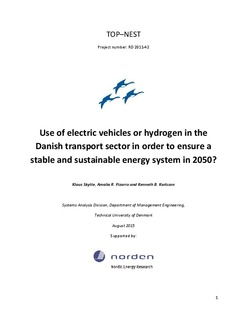| dc.contributor.author | Skytte, Klaus | |
| dc.contributor.author | Pizarro, Amalia R. | |
| dc.contributor.author | Karlsson, Kenneth B. | |
| dc.date.accessioned | 2015-09-16T15:31:13Z | |
| dc.date.available | 2015-09-16T15:31:13Z | |
| dc.date.issued | 2015-09-16 | |
| dc.identifier.uri | http://hdl.handle.net/11250/300343 | |
| dc.description.abstract | Denmark is one of the Northern European countries that have set up ambitious long-term targets to reduce GHG emissions from the transport as well as from other sectors. In Denmark, the target is to make the transport sector independent of fossil-fuel consumption by 2050 at the latest. This paper compares a likely scenario with two alternative ways to achieve the goal - either with a high percentage of electric vehicles (EV) or with a high percentage of hydrogen (H2) use in the transport sector. The STREAM model - an energy scenario simulating tool - provides insight into different potential energy mixes and calculates socio economic costs. It is used to model the different transport scenarios and their system integration with the electricity and heating sectors. The major findings of this paper are that an increased share of electric vehicles could significantly reduce the socio-economic cost of the energy system in 2050. Electricity demand for H2 generation via electrolysis is more flexible than EV charging and the production can therefore, to a larger degree be used to out-balance variable electricity surplus from a high share of wind and solar energy in the power system. H2 production may generate heat that can be used as district heating - replacing traditional heating plants, heat pumps and in some cases combined heat and power plants. Therefore, the energy generation mix (electricity and heat) is more affected in the H2 scenario than in the EV scenario. Whether the H2 scenario is more costly to implement than the EV scenario mainly depends on the technological development - especially the improvement on the efficiency of the conversion from electricity to H2. It is found that a higher efficiency in the H2 production via electrolysis plays a more important role in decreasing the total cost of the energy system than a lower level of electrolyser capital cost. Therefore, the major driver of a successful H2 scenario is a high efficient and flexible H2 production in 2050. In other words, from a socio-economic view point this paper estimates that the technological path in innovation should have efficiency as its main driver towards 2050. | nb_NO |
| dc.language.iso | eng | nb_NO |
| dc.relation.ispartofseries | TOP–NEST; | |
| dc.rights | Navngivelse-Ikkekommersiell 3.0 Norge | * |
| dc.rights.uri | http://creativecommons.org/licenses/by-nc/3.0/no/ | * |
| dc.subject | Energy | nb_NO |
| dc.subject | Environment | nb_NO |
| dc.subject | Electric vehicles (EV) | nb_NO |
| dc.subject | hydrogen use | nb_NO |
| dc.subject | renewable energy | nb_NO |
| dc.subject | e-mobility | nb_NO |
| dc.subject | STREAM model | nb_NO |
| dc.title | Use of electric vehicles or hydrogen in the Danish transport sector in order to ensure a stable and sustainable energy system in 2050? | nb_NO |
| dc.type | Research report | nb_NO |
| dc.relation.project | TOP–NEST | nb_NO |

